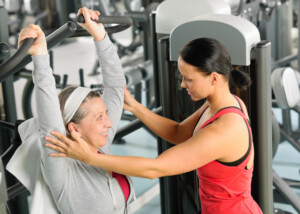
You’re now retired or close to retirement age and want a personal trainer.
Here are 10 ways to know that the trainer you choose will be the perfect fit.
Older people, with all their life experience, often do not know nearly as much about proper strength training form and movement as they think they do.
For example, something as seemingly simple as a seated overhead dumbbell press can be challenging with even very light weight.
I always see people, especially older ones, doing things at the gym WRONG.
This will set them up for injury or failure to reach their fitness or weight loss goals.
So if you’ve decided it’s time for a personal trainer, do not let anyone talk you out of this.
Instead, pay attention when you’re looking around at your gym for the “right trainer.”
10 Signs of a Great Personal Trainer if You’re Older
#1 … Prior to your first sample session with them, they want to know if you have any diagnosed medical conditions.

Shutterstock/Photographee.eu
There are conditions that change the way a person should exercise. For example, diabetics need to check their blood sugar during exercise.
People with osteoporosis need to avoid certain kinds of exercise. So do people with knee and hip replacements.
#2 … Also prior to the first sample session, they want to know if any part of your body hurts when you move in certain ways.

Shutterstock/aijiro
For instance, when you get out of bed in the morning, do your heels hurt?
When you reach overhead, does your upper arm hurt?
#3 … The trainer doesn’t have their older clients spending a lot of time sitting on a big bouncy ball.
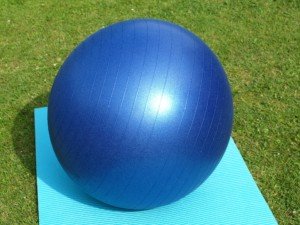
Unless the client is undergoing rehab exercises, this just isn’t necessary simply because the client is older.
#4 … The trainer’s clients always have good form.
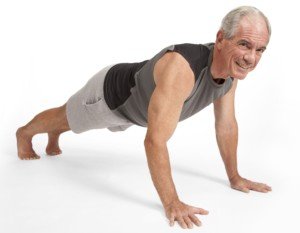
Shutterstock/Straight 8 Photography
But keep in mind that a novice to exercise won’t always recognize poor form from good form.
However, if you happen to be able to tell the difference, then of course, look for trainers whose clients always have excellent form!
#5 … The client isn’t chatting while exercising.
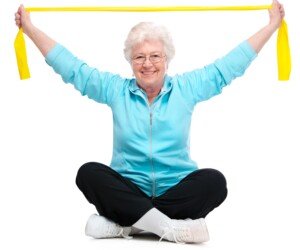
Shutterstock/Alexander Raths
The client appears focused and dedicated rather than engaging in a social session.
Though it’s important to have a warm connection with your trainer, this doesn’t mean that while you’re performing a set or drill, you should be chatty.
The routine should be demanding enough to force you to concentrate on it (breathing, form, effort).
If you’re able to socialize during a working set, you’re not getting your money’s worth.
#6 … The client is doing things that appear to have a carryover to ADL: the activities of daily living.
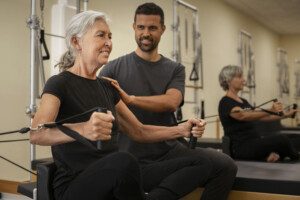
Freepik
This might be any variety of pulling routines.
This might be an older client walking around the track while holding a heavy ball.
The client may be walking up and down a staircase several times while holding dumbbells.
The trainer might be timing how fast the client can get off the floor and up on their feet.
Any drills such as these are indicative of a trainer who’s mindful of training their aged client to be more agile, coordinated and stable in the ADL. This helps prevent falls!
#7 … A trainer who encourages their client to use a treadmill without holding on.
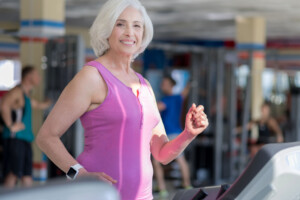
Shutterstock/Dmytro Zinkevych
Unless the client requires a cane or walker, allowing holding onto a treadmill is patronizing and dis-empowering.
And how does this carry over to the ADL? Holding onto a treadmill isn’t going to make a 62-year-old more efficient at walking across a knobby parking lot where there are no rails to cling onto.
#8 … The client is performing mostly compound weightlifting exercises: ones that use more than one joint, rather than mostly isolation exercises (biceps curls, triceps extensions, side dumbbell lifts, sit-ups).
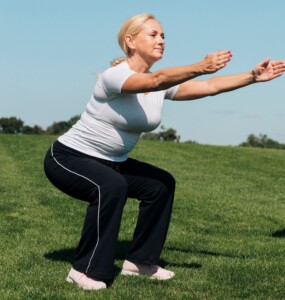
Freepik.com
#9 … The client is doing the deadlift and some form of squat (not necessarily with a barbell across the back).
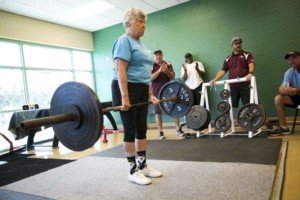
Tampabay.com
The deadlift and various forms of the squat have massive carryover to the ADL.
Of course, the trainer should have already vetted their client for performing deadlifts and squats, i.e., no pre-existing knee pain or spinal pathology.
#10 … At least half the client’s program consists of performing free-weight exercises while on their feet.
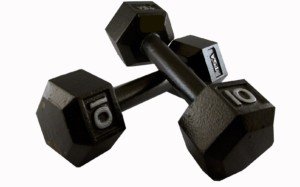
In the ADL, the ability to stand and walk efficiently is extremely important, especially while manipulating objects in space, such as picking up a potted plant or other weighted object and carrying it to the next room.
If most of the exercises are done on sit-down machines, this will have much less application to real-life movement.
Of course, if the older client has an orthopedic issue that makes prolonged standing painful, then they need to avoid prolonged standing.
Nevertheless, in real life, when it’s time to move something against resistance, you’ll almost always be on your feet.
A personal trainer’s job is to empower their older clients (whether they’re novices or have been working out for years), rather than enable them or underestimate them.
 Lorra Garrick has been covering medical and fitness topics for many years, having written thousands of articles for print magazines and websites, including as a ghostwriter. She’s also a former ACE-certified personal trainer.
Lorra Garrick has been covering medical and fitness topics for many years, having written thousands of articles for print magazines and websites, including as a ghostwriter. She’s also a former ACE-certified personal trainer.
.

